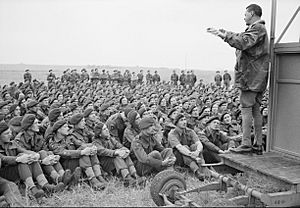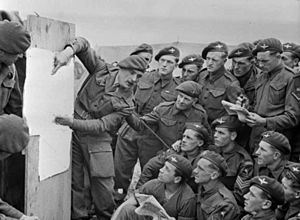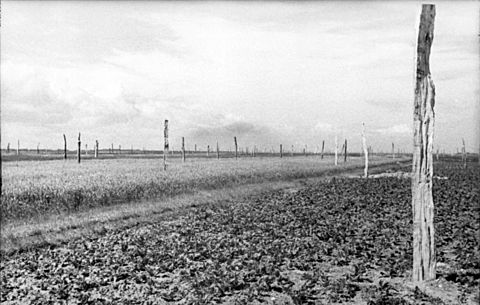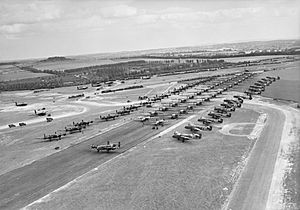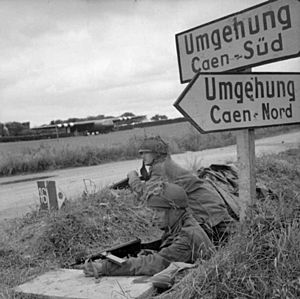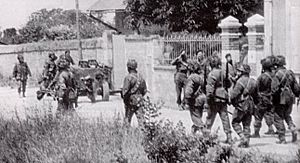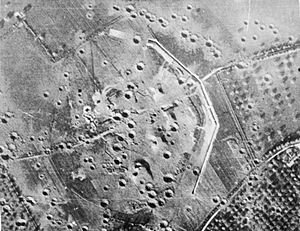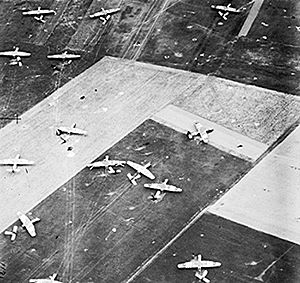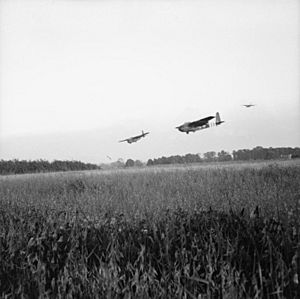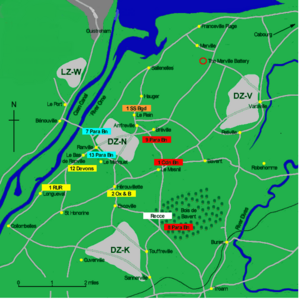Operation Tonga facts for kids
Quick facts for kids Operation Tonga |
|||||||
|---|---|---|---|---|---|---|---|
| Part of the Normandy landings | |||||||
 British pathfinders of the 22nd Independent Parachute Company synchronising their watches in front of an Armstrong Whitworth Albemarle |
|||||||
|
|||||||
| Belligerents | |||||||
| Commanders and leaders | |||||||
| Strength | |||||||
| 8,500 men | Approx 16,000 | ||||||
| Casualties and losses | |||||||
| 800 dead and wounded |
|
||||||
Operation Tonga was a secret mission during World War II. It involved the British 6th Airborne Division, a special group of soldiers who jumped from planes or landed in gliders. This operation happened between June 5 and 7, 1944. It was a key part of Operation Overlord, also known as the D-Day landings.
The paratroopers and glider troops, led by Major-General Richard Nelson Gale, landed in Normandy, France. Their main goals were to capture two important bridges over the Caen Canal and Orne River. These bridges were needed for other Allied forces to move forward. They also had to destroy other bridges to stop German troops from using them. Another big task was to attack and destroy the Merville Gun Battery. This was a German artillery base that could shoot at Sword Beach, where many Allied soldiers would land.
The mission faced challenges like bad weather and pilots getting lost. This caused many troops to land in the wrong places. For example, the 9th Parachute Battalion, which was supposed to destroy the Merville battery, had very few soldiers gathered when they had to attack. Despite these problems, the battery was successfully attacked and its guns were put out of action. The division also achieved its other goals.
A small group of glider troops, from the 2nd Battalion Oxfordshire and Buckinghamshire Light Infantry, quickly captured the two main bridges. Other bridges were destroyed by the division. The British soldiers then set up a strong defensive area around the captured bridges. They fought off several German attacks until more Allied ground forces arrived from the beaches. The actions of the 6th Airborne Division made it hard for the Germans to communicate and organize. This helped protect the soldiers landing on the beaches during the first, most dangerous hours.
Contents
Planning the Invasion
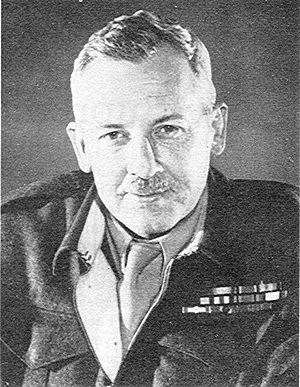
Operation Tonga was part of the bigger plan called Operation Overlord. This was the Allied plan to invade and free German-controlled France. Planning for this huge invasion started in May 1943. Leaders like President Franklin D. Roosevelt and British Prime Minister Winston Churchill decided to gather all Allied forces in the United Kingdom. They set a target date of May 1944 for the invasion.
A special team, led by Lieutenant-General Frederick E. Morgan, was created to plan the invasion. Early plans for Overlord included using airborne forces to help the ground troops. These airborne troops would land near the beaches to protect the landing areas.
Later, General Sir Bernard Montgomery took charge of all ground forces for the invasion. He changed the plan to make the landing area wider. Five divisions would land on the beaches. Three airborne divisions would land on either side of the beaches to protect the flanks. British airborne forces were assigned to the eastern side, and American forces to the west.
Getting Ready for Battle
British Soldiers Prepare
The 6th Airborne Division, led by Major-General Richard Gale, was chosen for the airborne operations on the eastern side. This division was quite new, formed in April 1943. Operation Overlord would be its first time fighting.
In February 1944, Major-General Frederick Browning, who commanded all British airborne forces, told Gale about the division's mission. This mission was given the codename Operation Tonga.
The first plan for Tonga was small, only using one parachute brigade. Gale disagreed, saying that one brigade wasn't enough. He asked for the entire division to be used. Browning agreed, and Gale began planning for the larger operation.
The division had three main tasks for Tonga. First, they had to capture two bridges over the Caen Canal and the Orne River. These bridges were at Bénouville and Ranville. They then had to defend them against German attacks. Second, they needed to destroy the strong Merville coastal artillery battery. This would stop it from firing on British forces landing on Sword Beach. Third, they had to destroy several bridges over the River Dives near towns like Varaville and Troarn. After completing these tasks, the division would hold the area until other British ground forces arrived.
Detailed planning for Tonga began in February. More transport aircraft were assigned to carry the whole division. The pilots and crews practiced flying in formation. The 6th Airborne Division also did several large training exercises. They practiced dropping entire brigades by parachute or glider.
Glider units spent many hours practicing landings. They practiced landing near the bridges and the Merville battery, both during the day and at night. Engineers practiced quickly removing obstacles similar to those in Normandy.
The battalion assigned to destroy the Merville battery spent two weeks at a special camp. They built a copy of the battery and practiced attacking it many times. The troops chosen to capture the main bridges practiced near the River Exe in England, which looked like their real targets.
Pilots were given thousands of maps and photos of the landing zones. They also studied models of the bridges and the Merville battery. A special film made from aerial photos helped them practice their flight paths.
German Defenses
The German forces defending the area around Caen and the River Orne were the 711th and 716th Infantry Divisions. These divisions were not considered very strong. They had older soldiers and conscripts from other countries. They also had a mix of anti-tank guns and artillery.
Near Caen, the 21st Panzer Division was stationed. This division had some older tanks and armored vehicles. Further away, the Panzer Lehr Division and the 12th SS Panzer Division Hitlerjugend were also a threat. These divisions had many tanks and could arrive quickly.
Field Marshal Erwin Rommel was in charge of German coastal defenses. He ordered many improvements to the defenses, especially inland. These improvements included planting many mines. They also put up "Rommel's asparagus" – tall poles with wires. Many of these poles had mines or traps to destroy gliders and hurt airborne troops.
The Merville artillery battery was very well protected. It had bunkers, machine-gun nests, and observation posts. The battery itself had a command post, blockhouses, and four large concrete structures for artillery guns. It was surrounded by barbed wire, a minefield, and an anti-tank ditch.
The Battle Begins
The First Flights
Operation Tonga started at 10:56 PM on June 5. Six Handley Page Halifax planes took off, pulling six Horsa gliders. These gliders carried the special force led by Major John Howard. Their mission was to capture the bridges over the Caen Canal and the Orne River.
A few minutes later, between 11:00 PM and 11:20 PM, six Armstrong Whitworth Albemarle planes took off. They carried pathfinders from the 22nd Independent Parachute Company. These pathfinders were supposed to mark the landing zones for the rest of the airborne troops. More planes followed, carrying parts of the 9th Parachute Battalion and the 1st Canadian Parachute Battalion.
Thirty minutes later, the main group of planes carrying the division began to take off. This included 239 Douglas Dakota and Short Stirling planes, plus seventeen Horsa gliders. They carried most of the 3rd and 5th Parachute Brigades. Later, more gliders arrived with the divisional headquarters and anti-tank guns. The last group of gliders carried engineers and soldiers for the Merville Battery attack.
Capturing the Bridges
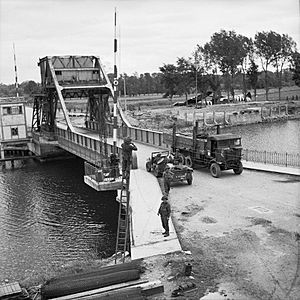
Major Howard's special force was the first part of the 6th Airborne Division to land. Their six gliders landed between 12:15 AM and 12:20 AM. Three landed near the Caen Canal bridge and two near the Orne River bridge. One glider landed seven miles away by mistake.
Once on the ground, the soldiers quickly attacked the German positions. At the Caen Canal bridge, they attacked trenches and a concrete bunker. At the Orne River bridge, they silenced a machine-gun nest. Both bridges were captured within fifteen minutes, with very few casualties. The soldiers also found that the bridges had not been rigged with explosives, which was a relief.
While waiting for the rest of the division, the force had to fight off several German attempts to retake the bridges. At 1:30 AM, two German tanks tried to cross the Caen bridge. They were stopped, and one tank was destroyed by a PIAT anti-tank weapon.
Pathfinders' Challenges
The pathfinders were supposed to mark the drop zones for the division. However, due to heavy clouds and navigation errors, only one pathfinder team landed correctly. Other planes had to make multiple passes. One team landed in the wrong zone and set up markers there, causing many paratroopers to drop in the wrong area.
A pathfinder team for the Merville Battery was almost wiped out. An RAF bombing raid meant for the battery accidentally hit their area instead.
5th Parachute Brigade's Fight
Brigadier Nigel Poett's 5th Parachute Brigade was scattered badly when they dropped. The 7th Parachute Battalion, for example, had only about 40% of its soldiers by 3:00 AM. Many supply containers were also lost, meaning they had few heavy weapons or radios.
However, the 7th Battalion managed to meet up with the 2nd Oxfordshire and Buckinghamshire Light Infantry. They set up defenses against German counter-attacks. The first organized German attacks came between 5:00 AM and 7:00 AM. These were uncoordinated attacks by tanks, armored cars, and infantry. At 10:00 AM, the German Air Force (Luftwaffe) tried to destroy the Caen bridge. A single plane dropped a bomb, but it did not explode. Two German boats also tried to attack the bridge but were driven back.
As the day went on, the 2nd Battalion, 192nd Panzergrenadier Regiment, counterattacked near Bénouville. They tried to reach the bridges. The British troops held their ground, destroying 13 of 17 tanks. The British then moved into Bénouville and cleared out the Germans in house-to-house combat. By midday, most of the missing soldiers from the 7th Parachute Battalion had arrived. Despite fierce attacks, the battalion held the bridges until 7:00 PM. Then, leading elements of the British 3rd Infantry Division arrived and took over.
The brigade's other two battalions, the 12th and 13th, were also scattered. When they gathered, neither had more than 60% of their strength. The 12th Parachute Battalion secured the village of Le Bas de Ranville by 4:00 AM. The 13th Parachute Battalion captured Ranville around the same time, facing stronger resistance.
One company from the 13th Parachute Battalion stayed at the drop zone. They protected engineers who were clearing obstacles for the 6th Airborne Division headquarters to land safely. Both battalions held their areas until ground forces from the beaches relieved them. The 12th Parachute Battalion faced heavy mortar and artillery fire. They fought off two German counter-attacks from the 125th Panzer Grenadier Regiment.
3rd Parachute Brigade's Mission
The 3rd Parachute Brigade (Brigadier James Hill) also landed at the same time and faced similar problems. Its units were scattered due to poor navigation and cloud cover.
The 8th Parachute Battalion was supposed to destroy three bridges. Many of its paratroopers landed far from their target. When the commanding officer, Alastair Pearson, arrived at the meeting point, he found only 30 paratroopers. By 3:30 AM, this number grew to 140, but the engineers needed to destroy the bridges were still missing.
Pearson sent a small group to the bridges at Bures. They found that other engineers had already destroyed them. The rest of the battalion moved to a crossroads near Troarn. A small team went into Troarn to check on the bridge there. They found it partially destroyed. Engineers then used explosives to widen the damaged part. The battalion then moved north to expand the airborne defensive area.
The 1st Canadian Parachute Battalion had to destroy two bridges, one at Varaville and one at Robehomme. Like other units, they were scattered. Some landed 10 miles away, others near the invasion beaches. Many drowned in flooded areas around Varaville due to the weight of their equipment.
A group of paratroopers reached the Robehomme bridge and found it intact. By 3:00 AM, the engineers for demolition had not arrived. So, the paratroopers used the small amount of explosives they had to weaken the bridge. The engineers finally arrived at 6:00 AM and finished destroying it.
Meanwhile, another company of the battalion tried to clear German soldiers from Varaville. They also had to destroy a gun and a radio transmitter. This company was very small, with only a fraction of its 100 men. A small group attacked German fortifications with about 96 Germans and machine guns. The Germans caused many casualties. The fighting continued until 10:00 AM when the Germans surrendered after being hit by mortars. British Commandos then relieved the paratroopers.
Attack on Merville Gun Battery
The 9th Parachute Battalion had several goals: destroy the Merville artillery battery, capture Le Plein village, block roads, and capture a German Navy headquarters. However, the battalion was scattered. Lieutenant-Colonel Terence Otway, the commander, landed near a German command post. After a brief fight, Otway reached the drop zone at 1:30 AM.
By 2:35 AM, only 110 paratroopers had gathered. They had only one machine gun and a few Bangalore torpedoes (special explosives). Otway was ordered to destroy the battery by 5:30 AM. He decided he couldn't wait for more men. He set off for the battery at 2:45 AM with 150 paratroopers.
The battalion reached the battery at 4:00 AM. They met the few surviving pathfinders. The pathfinders marked areas for the explosives. The battalion split into four attack groups, one for each gun position. They were ready by 4:30 AM, when gliders carrying engineers arrived over the battery.
Only two of the three gliders made it to Normandy. One landed two miles away, the other at the edge of the battery's minefield. The troops from this glider fought German soldiers. Otway launched the assault as soon as the first glider overshot. Explosives were set off to create paths through the outer defenses. The Germans were alerted and fired back, causing heavy casualties.
Only four men reached Casemate Four, one of the gun positions. They disabled it by firing into openings and throwing grenades. The other gun positions were cleared with grenades. The German crews had forgotten to lock the doors. The paratroopers took some prisoners. They then used explosives to disable the artillery pieces. They found that the guns were older, from World War I, not modern 150mm weapons.
The paratroopers did their best with the explosives they had. They used Gammon bombs to disable one gun and jammed shells into others. However, at least one gun was later put back into action by the Germans. After the attack, the paratroopers gathered prisoners and their wounded and left. They had no radio, so if no signal was sent by 5:30 AM, the light cruiser HMS Arethusa would shell the battery.
The paratroopers achieved their main goal, but at a high cost: 50 dead and 25 wounded, a 50% casualty rate. The battalion then attacked Le Plein, securing the village. The survivors moved to a meeting point at 5:30 AM. The battalion was too small to achieve its other goals.
Divisional Headquarters and Later Landings
At 3:35 AM, the 6th Airborne Division headquarters landed by glider. Only a few gliders missed the landing zone. Once the headquarters staff gathered, they moved to Le Bas de Ranville. They made contact with the 5th Parachute Brigade headquarters at 5:00 AM. They contacted the 3rd Parachute Brigade headquarters at 12:35 PM. The division then met up with the 1st Special Service Brigade at 1:53 PM.
At 9:00 PM, Operation Mallard began. This was the final wave of the 6th Airborne Division's landings. It included 220 Horsa and Hamilcar gliders carrying the 6th Airlanding Brigade and other units. The gliders landed under heavy fire from German positions. Casualties were light, and within 90 minutes, the glider troops had gathered. By midnight on June 7, almost the entire 6th Airborne Division was in position.
By the end of the day, the 3rd Parachute Brigade held a 4-mile front. The 9th Parachute Battalion was at Le Plein, the 1st Canadian Parachute Battalion at Les Mesneil, and the 8th Parachute Battalion in the southern part of the Bois de Bavent. The 5th Parachute Brigade had the 12th Parachute Battalion at Le Bas de Ranville and the 13th Parachute Battalion holding Ranville. The 7th Parachute Battalion was in reserve. The 6th Airlanding Brigade was ready to expand the defensive area. The 1st Special Service Brigade was holding villages north and northeast of DZ N.
After the Battle
Casualties and Losses
The 6th Airborne Division had 800 casualties (dead and wounded) between June 5 and 7. This was out of 8,500 men deployed. German losses were about 400 dead and 400 captured. Fourteen German tanks were lost during counterattacks near the bridges. One German gunboat on the Caen Canal was also destroyed.
What Happened Next
From June 7 to June 10, the 6th Airborne Division fought off many German attacks. They kept control of the area between the Rivers Orne and Dives. On June 14, the 51st (Highland) Infantry Division took over the southern part of the bridgehead.
On June 10, the decision was made to expand the defensive area east of the River Orne. The 6th Airborne Division was given this task. On June 11, the 5th Battalion, Black Watch (Royal Highland Regiment), attacked the town of Bréville. They met very strong resistance and had to retreat after many casualties. The next day, the 3rd Parachute Brigade faced heavy artillery fire and attacks by German tanks and infantry.
In the following weeks, the 6th Airborne Division was joined by the Dutch Princess Irene Brigade and the 1st Belgian Infantry Brigade. On August 7, the division began preparing for new attacks. From August 16 to August 26, the division advanced against strong German opposition. They reached their goal, the mouth of the River Seine. In nine days, they advanced 45 miles. They freed 400 square miles of German-occupied France and captured over 1,000 German soldiers.
Between June 6 and August 26, the division had 4,457 casualties. This included 821 killed, 2,709 wounded, and 927 missing. The division was finally pulled from the front lines on August 27. They returned to England in early September.
Images for kids


